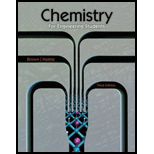
Concept explainers
4.24 Ammonia gas can be prepared by the reaction
If 112 g of CaO reacts with 224 g of NH4Cl, how many moles of reactants and products are there when the reaction is complete?
Interpretation:
To calculate how many moles of reactants and products will be left after the completion of reaction.
Concept introduction:
- Reactants decrease in moles, Products increase in moles.
- Stoichiometry relates all species to their atomic ratios.
- Limiting reactant will never be leftover if 100 % completion.
- Excess reactant will always be leftover.
Given:
Answer to Problem 4.26PAE
Solution:
Explanation of Solution
When a reaction occurs, there are reactants reacting in order to form new products. The reactants are not typically added in a 100 % stoichiometric ratio, therefore, there is always a limiting and an excess reactant.
It is much easier to convert to molar units, rather than mass units, in order to verify the reactants and products present.
Step 1: Balance Reaction
The reaction is already balanced
Step 2: Change all mass units to mol units
Step 3: Relate stoichiometry
Step 4: Moles reacted
Identify the limiting reactant (
Excess reactant of
Step 5: Moles produced
Moles of product
Moles of product
Moles of product CaCl2 formed
Use stoichiometry to verify the ratio between species, that is, reactants and products after the reaction is over.
Want to see more full solutions like this?
Chapter 4 Solutions
Chemistry for Engineering Students
- Hi can you please help me solve this problem? thank youarrow_forwardAn electrode process takes place at a metal-solution interface. Indicate the current condition that must be met for Faradaic rectification to occur.arrow_forwardAt a metal-solution interface, an electron is exchanged, and the symmetry factor beta < 0.5 is found in the Butler-Volmer equation. What does this indicate?arrow_forward
 Chemistry for Engineering StudentsChemistryISBN:9781337398909Author:Lawrence S. Brown, Tom HolmePublisher:Cengage Learning
Chemistry for Engineering StudentsChemistryISBN:9781337398909Author:Lawrence S. Brown, Tom HolmePublisher:Cengage Learning General, Organic, and Biological ChemistryChemistryISBN:9781285853918Author:H. Stephen StokerPublisher:Cengage Learning
General, Organic, and Biological ChemistryChemistryISBN:9781285853918Author:H. Stephen StokerPublisher:Cengage Learning Chemistry & Chemical ReactivityChemistryISBN:9781337399074Author:John C. Kotz, Paul M. Treichel, John Townsend, David TreichelPublisher:Cengage Learning
Chemistry & Chemical ReactivityChemistryISBN:9781337399074Author:John C. Kotz, Paul M. Treichel, John Townsend, David TreichelPublisher:Cengage Learning Chemistry & Chemical ReactivityChemistryISBN:9781133949640Author:John C. Kotz, Paul M. Treichel, John Townsend, David TreichelPublisher:Cengage Learning
Chemistry & Chemical ReactivityChemistryISBN:9781133949640Author:John C. Kotz, Paul M. Treichel, John Townsend, David TreichelPublisher:Cengage Learning General Chemistry - Standalone book (MindTap Cour...ChemistryISBN:9781305580343Author:Steven D. Gammon, Ebbing, Darrell Ebbing, Steven D., Darrell; Gammon, Darrell Ebbing; Steven D. Gammon, Darrell D.; Gammon, Ebbing; Steven D. Gammon; DarrellPublisher:Cengage Learning
General Chemistry - Standalone book (MindTap Cour...ChemistryISBN:9781305580343Author:Steven D. Gammon, Ebbing, Darrell Ebbing, Steven D., Darrell; Gammon, Darrell Ebbing; Steven D. Gammon, Darrell D.; Gammon, Ebbing; Steven D. Gammon; DarrellPublisher:Cengage Learning Chemistry: The Molecular ScienceChemistryISBN:9781285199047Author:John W. Moore, Conrad L. StanitskiPublisher:Cengage Learning
Chemistry: The Molecular ScienceChemistryISBN:9781285199047Author:John W. Moore, Conrad L. StanitskiPublisher:Cengage Learning





